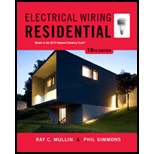
Electrical Wiring Residential
18th Edition
ISBN: 9781285170954
Author: Ray C. Mullin, Phil Simmons
Publisher: Cengage Learning
expand_more
expand_more
format_list_bulleted
Concept explainers
Textbook Question
Chapter 4, Problem 4R
What determines the ampacity of a wire?
Expert Solution & Answer
Trending nowThis is a popular solution!

Students have asked these similar questions
Find the valve of voltage Vx using SUPERPOSITION
1 M
FA
www
4
5
M
MAA
12V
-
$10
33
M
23
+x
mn
6
8A
Find the Valve of Voltage Vy using SUPERPOSITION
الله
8
ZV
ДАДА
6
5
ча
4
w
3
1
mm
2A
MW
Find the value of voltage
Using SUPER POSITION.
GV
www
6
M
33
ww
ЧА
5.
123
AM
4
4
۱۹۷
Chapter 4 Solutions
Electrical Wiring Residential
Ch. 4 - The largest size solid conductor generally...Ch. 4 - What is the minimum branch-circuit wire size that...Ch. 4 - What exceptions, if any, are there to the answer...Ch. 4 - What determines the ampacity of a wire?Ch. 4 - What unit of measurement is used for the diameter...Ch. 4 - What unit of measurement is used for the...Ch. 4 - What is the voltage rating of the conductors in...Ch. 4 - Indicate the allowable ampacity of the following...Ch. 4 - Prob. 9RCh. 4 - What are the colors of the conductors in...
Ch. 4 - For nonmetallic-sheathed cable, may the...Ch. 4 - Prob. 12RCh. 4 - Under what condition may nonmetallic-sheathed...Ch. 4 - a. What is the maximum distance permitted between...Ch. 4 - Prob. 15RCh. 4 - Prob. 16RCh. 4 - Prob. 17RCh. 4 - Prob. 18RCh. 4 - Prob. 19RCh. 4 - Circle the correct answer to the following...Ch. 4 - When running Type NM cable through a bored hole in...Ch. 4 - Where is the main service-entrance panel located...Ch. 4 - Is it permitted to use flexible metal conduit over...Ch. 4 - Liquidtight flexible metal conduit may serve as a...Ch. 4 - It is permissible for an electrician to connect...Ch. 4 - Terminals of switches and receptacles marked...Ch. 4 - Wire connectors marked AL/CU are suitable for use...Ch. 4 - A wire connector bearing no marking or reference...Ch. 4 - When Type NM cable is run through a floor, it must...Ch. 4 - When nonmetallic-sheathed cables are bunched or...Ch. 4 - In diagrams A and B, nonmetallic-sheathed cable is...Ch. 4 - The marking on the outer jacket of a...Ch. 4 - A 120-volt branch circuit supplies a resistive...Ch. 4 - In problem 35, it is desired to keep the voltage...Ch. 4 - Prob. 37RCh. 4 - The allowable ampacity of a 4 AWG THHN from Table...Ch. 4 - If, because of some obstruction in a wall space,...Ch. 4 - The recessed fluorescent luminaires installed in...Ch. 4 - Prob. 41RCh. 4 - What size overcurrent device protects the...Ch. 4 - May the 20-ampere small-appliance branch circuits...Ch. 4 - A 30-ampere branch circuit is installed for an...Ch. 4 - In many areas, metal framing members are being...Ch. 4 - Are set screwtype connectors permitted to be used...Ch. 4 - Most armored cable today has 90C conductors. What...Ch. 4 - If you saw two different types of SE cables, how...Ch. 4 - Circle the correct answer defining the type of...
Knowledge Booster
Learn more about
Need a deep-dive on the concept behind this application? Look no further. Learn more about this topic, electrical-engineering and related others by exploring similar questions and additional content below.Similar questions
- Please explain in detail. I am most confused on how to get the transfer functions. thank youarrow_forwardPlease explain step by step in detail. I am most confused about the table. Thank youarrow_forwardUsing the block diagram or solution, show that the expected gain in the transfer function CA' (s)/Q'(s) is negative. Please explain how to approach this. No typed answers where the equation is in one line and it's hard to understand, please дома dela 1 C_AO G2(s) G3(5) dCA(t) dt dT' (t) dt = 2 Q beta 3-a G1(s) G4(s) (-AHko E koe RT + EKOČA RT2 E e E F T' (t) + Co (t) E 1 (All) (- -)+(y) = pcp eRT CA(t) + Е КОСАДНЕ PCPRT2 eRT T'(t) + Q'(t) 2 Tarrow_forward
- can you please answerarrow_forwardThe line diagram is of a standard forward/reverse/stop pushbutton station for forwarding and reversing a motor. Included in the circuit are mechanical and auxiliary contact interlocking. Also included are a forward overtravel limit switch to stop the motor in forward and a reverse overtravel limit switch to stop the motor in reverse. Overload protection is common to both forward and reverse directions. Complete the wiring diagram based on the line diagram. Do not make any wire splices or additional terminal connections on the wiring diagram (notice how they make multiple connections in the power circuit). All connections must run from terminal screw to terminal screw complete the wiring diagram based on the line diagram. Do not make any wires splices or additional terminal connections on the wiring diagram. All connections must run from terminal screw to terminal screwarrow_forward6.7 Consider a baseband binary PAM system that transmits at 3600 bps with a bit error rate less than 10-4. The channel introduces no distortion, but attenuates the signal by 20 dB and has a bandwidth of 2.4 kHz. The channel noise is AWGN with a power spectral density of 10-14 watts per Hertz (W/Hz). Design the optimum transmitting and receiving filters, and determine the required transmit power.arrow_forward
arrow_back_ios
SEE MORE QUESTIONS
arrow_forward_ios
Recommended textbooks for you
 EBK ELECTRICAL WIRING RESIDENTIALElectrical EngineeringISBN:9781337516549Author:SimmonsPublisher:CENGAGE LEARNING - CONSIGNMENT
EBK ELECTRICAL WIRING RESIDENTIALElectrical EngineeringISBN:9781337516549Author:SimmonsPublisher:CENGAGE LEARNING - CONSIGNMENT Electricity for Refrigeration, Heating, and Air C...Mechanical EngineeringISBN:9781337399128Author:Russell E. SmithPublisher:Cengage Learning
Electricity for Refrigeration, Heating, and Air C...Mechanical EngineeringISBN:9781337399128Author:Russell E. SmithPublisher:Cengage Learning

EBK ELECTRICAL WIRING RESIDENTIAL
Electrical Engineering
ISBN:9781337516549
Author:Simmons
Publisher:CENGAGE LEARNING - CONSIGNMENT

Electricity for Refrigeration, Heating, and Air C...
Mechanical Engineering
ISBN:9781337399128
Author:Russell E. Smith
Publisher:Cengage Learning
Capacitors Explained - The basics how capacitors work working principle; Author: The Engineering Mindset;https://www.youtube.com/watch?v=X4EUwTwZ110;License: Standard YouTube License, CC-BY